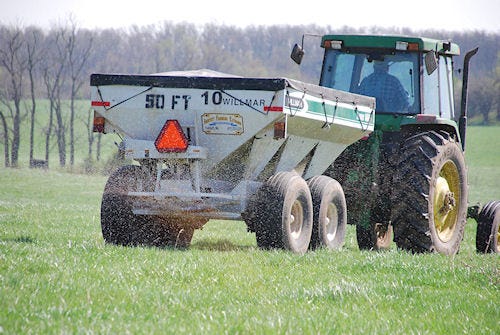May 27, 2011

For years, poultry litter has been valued as fertilizer on pastures and hayfields. Fairly inexpensive to buy, it contains a wealth of nutrients, including nitrogen, phosphorus and potassium and calcium.
In fact, many fields in Missouri could benefit from responsible applications of poultry litter, according to Tim Schnakenberg, agriculture and rural development specialist, University of Missouri Extension.
"Using litter successfully requires an understanding by the users of what happens to nutrients after their application is on land," Schnakenberg explains.

Extension specialists recommend a soil test, in order to check existing phosphorus and other mineral levels, before an application is made. If phosphorus is too high, the litter may need to be stored or sold to another farmer.
For example, it is important to know that there is a 50% or greater loss of nitrogen to the atmosphere when litter is applied on top of the ground. The process that causes the loss of nitrogen is actually what makes litter smell. But most of the loss can be avoided if the litter is incorporated into the soil.
"This excellent fertilizer source should be used in a way that leads to the greatest benefit to the farmer while also being safe for the environment," Schnakenberg says.
Over-applications may lead to nutrient runoff into streams, ponds and our lakes. Ponds near litter applications can develop high levels of algae and weed growth due to excess phosphorus and nitrogen running into them. There is a lot of attention being given these days to excess phosphorus runoff. This concern is justifiable in areas where excess applications may be made.
"There often is a distribution problem with litter due to the expense of transferring it to areas that need it most," Schnakenberg notes.
Conduct soil tests to verify if applications are needed. Schnakenberg also says that applications on pastures need to be closely monitored since animal manure from cattle on pasture readily recycles nutrients back to the soil.
Unlike crop or hay fields where larger amounts of nutrients are removed with the crop, manure left on pastures returns 90% of the phosphorus in the forage crop back to the soil. "With continued litter application on these fields a buildup can occur and a phosphorus-saturated soil may lead to excess run-off," Schnakenberg says.
Extension specialists recommend a soil test, in order to check existing phosphorus and other mineral levels, before an application is made. If phosphorus is too high, the litter may need to be stored or sold to another farmer.
If not stored or used properly, poultry litter can be harmful. Waste can go from being a poultry issue to a people issue pretty quick. That is why litter storage or application has to be done in a responsible fashion. Secure storage containers, protective barriers, planting trees, land grading systems and other techniques, as well as a nutrient management plan, are all important steps in order to protect the soil and water.
For suggestions on how to be responsible in the use of animal waste on a farm, contact your local MU Extension Center.
Source: MU Extension Southwest News Service
You May Also Like




